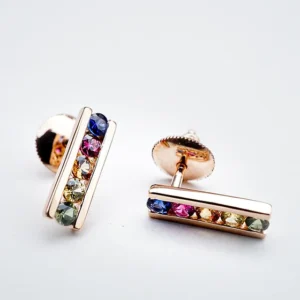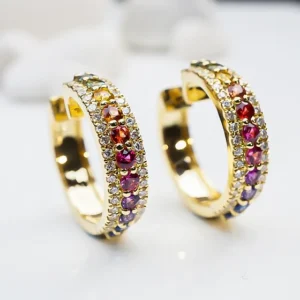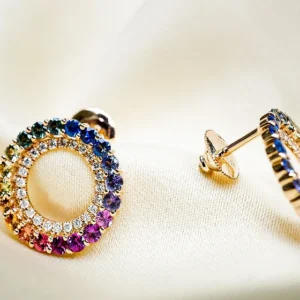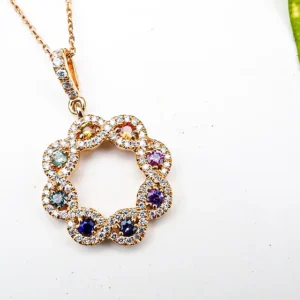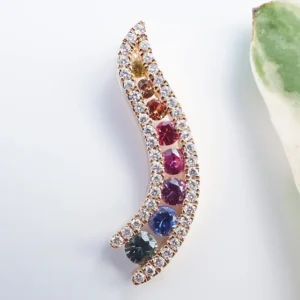Exploring the Brilliance of Pear Cut Diamonds: A Sparkling Guide
Diamonds have captivated human hearts for centuries with their unparalleled brilliance and timeless elegance. Among the many exquisite diamond cuts, the pear cut stands out for its unique teardrop shape, combining the elegance of a round cut with the flair of a marquise cut.
Table of Contents
In this comprehensive guide, we’ll delve into the world of pear cut diamonds, their characteristics, the 4Cs, popular settings, and more.
Introduction
From engagement rings that symbolize eternal love to statement jewelry that exudes individuality, pear cut diamonds have transcended mere gems to become iconic expressions of sophistication and glamour.
Their distinctive silhouette, reminiscent of a delicate teardrop, gracefully blends a softly rounded end with a sleek, pointed tip, resulting in an elongated gem that not only beautifully complements the finger’s natural curvature but also serves as a testament to the exquisite craftsmanship that shapes it.
This unique form not only captures and reflects light in a mesmerizing dance of brilliance but also encapsulates the wearer’s essence, making each piece a personal and captivating work of art that tells a story with every gleam.
Pear Cut Diamonds
A pear cut diamond, brilliantly reflecting light from its facets.
The Allure of Pear Cut Diamonds
Pear cut diamonds, affectionately known as “pear shaped diamonds,” encapsulate a harmonious fusion of time-honored tradition and contemporary allure.
Revered for their remarkable capacity to emanate an aura of refined elegance while simultaneously making a daring and confident proclamation, these exquisite gems hold an unmatched duality that resonates with individuals from all walks of life.
Their teardrop-inspired form effortlessly marries the grace of classic diamond cuts with the avant-garde spirit of modern design, resulting in a gem that is both timeless and cutting-edge.
This distinctive silhouette not only offers jewelers a canvas of endless creativity, allowing them to craft breathtaking solitaire settings that emphasize the diamond’s singular radiance or intricate multi-stone arrangements that celebrate its luxurious versatility, but it has also garnered an avid following among luminaries and fashion trendsetters who seek to make a grand impression while embracing their own unique style.
Understanding the 4 Cs
When evaluating any diamond, including the pear cut diamond, the 4 Cs play a crucial role:
Carat Weight
When it comes to pear cut diamonds, carat weight plays a captivating role in shaping their dimensions. The teardrop silhouette interacts harmoniously with carat weight, elongating gracefully towards the apex. Yet, beyond size, achieving harmony between dimensions and inherent qualities is the true essence.
This equilibrium ensures that the sparkle and brilliance of the pear cut aren’t compromised by size alone. In the realm of pear cut diamonds, this balance transforms a gemstone into a radiant masterpiece, transcending time and personal style.
Cut Quality
The magic of pear cut diamonds lies not just in their shape, but also in their cut’s influence on their radiance. In these gems, the cut choreographs a dance of light, creating a mesmerizing sparkle. A carefully crafted pear cut becomes a conductor of brilliance, capturing and refracting light to create a magical display.
The curves and apex harmonize, allowing the gem to embrace light from all angles. In the realm of pear cut diamonds, the cut transforms a gemstone into a radiant instrument that enchants hearts and captivates senses.
Color Spectrum
In the realm of pear cut diamonds, color and brilliance interplay captivatingly. Amidst a spectrum of diamond hues, timeless elegance often draws admirers to near-colorless grades. This preference aims to amplify the gem’s brilliance.
The elongated pear cut, adorned with facets, refracts light in a harmonious dance, subtly influenced by color. Opting for near-colorless grades lets brilliance shine unimpeded. In pear cut diamonds, this choice elevates enchantment and honors the gem’s radiant form.
Clarity Level
In the world of pear cut diamonds, clarity unveils a realm of imperfections, where each inclusion holds a gem’s story. Clarity is an art for the pear cut, as its teardrop shape elegantly embraces these formations, making each inclusion a unique mark of character.
Opting for pear cut diamonds with delicate inclusions honors authenticity, adding whispers of time and individuality. This choice emphasizes allure, harmonizing natural formations and mesmerizing light, captivating hearts with every flicker.
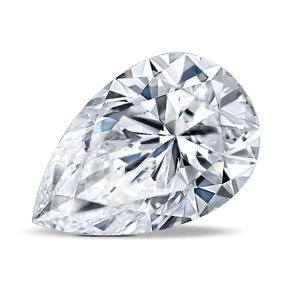
Pear Cut Diamond
Advantages of the Pear Cut
The allure of pear cut diamonds lies not only in their radiant sparkle but also in the profound attributes that set them apart in the realm of jewelry. The elongated silhouette of the pear cut possesses a transformative quality, gracefully elongating the fingers when set in a ring and bestowing an undeniable elegance upon the wearer.
This distinctive form thrives on its versatility, effortlessly adapting to a spectrum of settings and jewelry types, from the classic solitaire engagement ring to the intricate multi-stone necklace. As an embodiment of both tradition and innovation, the pear cut diamond boasts a design that defies convention and challenges expectations.
Its teardrop shape resonates as a symbol of individuality, making a bold statement that stands apart from the more traditional round or princess cuts. This unique juxtaposition of traits encapsulates the essence of pear cut diamonds, making them not only an adornment of beauty but also a canvas for self-expression that is as diverse and multifaceted as the gems themselves.
Selecting the Perfect Setting
The right setting enhances the beauty of a pear cut diamond. Consider these popular choices:
Solitaire Setting
In the world of pear cut diamonds, the solitaire setting stands as a timeless testament to elegance. This classic design places the diamond at the forefront, free from distractions. The solitaire setting lets the pear cut’s graceful shape and brilliance take center stage, creating a refined and enduring aesthetic that’s as captivating as it is simple.
Halo Setting
In the world of pear cut diamonds, the halo setting is a captivating companion. Encircling the teardrop gem with smaller diamonds, this setting enhances the pear cut’s sparkle, creating a celestial dance of light.
The combination of the pear cut’s elegant shape with the halo’s shimmering embrace forms a truly enchanting ensemble, elevating the gem’s luminosity and transforming it into a radiant masterpiece.
Vintage Setting
A vintage setting, intricate and detailed, adds a romantic and nostalgic touch to pear cut diamonds. This setting takes us on a journey through time, evoking the elegance of bygone eras and infusing each diamond with a sense of history and sentiment.
Ways to Enhance Sparkle of Pear Cut Diamonds
To keep your pear cut diamond dazzling, follow these tips:
Proper Lighting
Pear cut diamonds truly come alive in well-lit environments that accentuate their brilliance. Among lighting options, nothing compares to the magic of natural light. Sunlight streaming through windows or dancing beneath the sky interacts harmoniously with the diamond’s facets, igniting a mesmerizing sparkle.
The pear cut’s elegant silhouette captures and refracts this light, creating a breathtaking symphony of luminosity that captivates the eye. Natural light unveils the diamond’s inherent fire and scintillation, elevating the experience of admiring these gems to a realm of pure wonder and beauty.
Regular Cleaning
Maintaining the captivating allure of pear cut diamonds involves a gentle cleaning approach. Using a mild soap solution, a soft brush, and lukewarm water, the process delicately removes dirt and oils without compromising the gem’s intricate nature. This careful care preserves the diamond’s radiant shine, ensuring its enduring beauty over time.
Choosing the Right Metal Band
Choosing the ideal metal band for your pear cut diamond is an art that enhances its brilliance. White gold and platinum are popular choices, known for their luxurious luster that beautifully complements the gem’s radiance.
These metals form a backdrop that allows the diamond’s fire to shine, while their durability ensures the pear cut’s enchanting allure is safeguarded for years to come, creating an artistic expression that elevates the gem’s presence in a sophisticated manner.
Incorporating Pear Cut Diamonds into Jewelry
Pear Cut Engagement Rings
Pear cut engagement rings or pear shaped engagement rings are a symphony of romance and elegance, capturing hearts with their exquisite teardrop shape. This distinctive cut’s ability to elongate the finger and create a captivating focal point makes it a cherished choice for expressing love and commitment.
The pear cut’s versatile nature shines in various settings, from the timeless solitaire to the dazzling halo, allowing each ring to tell a unique story. Its marriage of tradition and modernity is a reflection of the couple’s journey, with the gem’s glistening facets mirroring the facets of their relationship.
Whether adorned with intricate details or kept minimalist, pear cut engagement rings and pear shaped diamond engagement rings encapsulate a profound promise, making every glance at the shimmering gem a reminder of love’s beauty and the bright future that lies ahead.
Necklaces and Pendants
Pear cut diamonds find a new canvas for their captivating beauty in necklaces and pendants, creating an enchanting adornment that dances with light. The teardrop shape, suspended delicately from a chain, draws the eye with its elegant silhouette, becoming a radiant centerpiece that elevates any ensemble.
Whether nestled in a simple setting that emphasizes its purity or surrounded by smaller diamonds that amplify its brilliance, the pear cut’s charm shines from the curve of the neck. These necklaces and pendants carry not only the diamond’s luminous allure but also a personal story, a gift of sentiment and style that speaks volumes without saying a word.
The wearer becomes the embodiment of grace and sophistication, while the gem’s gleam captures the essence of cherished moments, creating a wearable masterpiece that illuminates both the neck and the heart.
Earrings
In the realm of earrings, pear cut diamonds radiate a captivating allure, adorning the ears with a symphony of elegance and brilliance. The teardrop silhouette gracefully dangles, catching the light with every movement, creating a mesmerizing dance of sparkle that draws admiration.
Whether showcased as delicate studs that exude understated sophistication or as dramatic drops that command attention, the pear cut’s enchanting shape lends a touch of glamour to any occasion.
The earrings become more than mere accessories; they embody the wearer’s distinct style and celebrate the beauty of individuality. As they frame the face, these earrings not only elevate the overall aesthetic but also mirror the wearer’s inner glow, adding an ethereal touch that captivates and charms those who behold them.

A Pear Cut Diamond Solitaire Ring
Celebrity Pear Cut Diamonds
In the world of pear cut diamonds, its charm has captivated celebrities, making it a star on the red carpet. Icons like Victoria Beckham and Sophie Turner have embraced this cut’s elegance, showcasing it at premier events.
Their choice elevates the pear cut’s unique teardrop silhouette, adding sophistication and drama that resonates beyond gemstones, symbolizing timeless beauty and exquisite taste.
Caring for Your Precious Gem
Safeguarding the timeless beauty of your pear cut diamond requires meticulous care. Regular professional check-ups and secure storage are crucial for its preservation. These measures ensure its enduring allure and sentiment, making it a cherished treasure for generations to come.
Investing in Pear Cut Diamonds
Pear cut diamonds hold sentimental value and offer wise investment potential due to their timeless appeal. As symbols of love and commitment, they transcend eras, while their scarcity and unique aesthetics make them sought-after by collectors. Their versatility ensures continued relevance, connecting history with lasting value.
How to Spot a Quality Pear Cut Diamond
When assessing a pear cut diamond, focus on two key factors that denote quality. Symmetry is essential—the teardrop halves should mirror each other flawlessly, ensuring the diamond’s elegant silhouette.
Brilliant facets are equally crucial. Meticulously arranged, they capture and refract light with extraordinary brilliance from all angles, creating a captivating dance of sparkle. These attributes define a gem that embodies both artistry and nature’s beauty, transcending time and trends.
Customizing Your Own Pear Cut Diamond Ring
In the realm of pear cut diamonds, customization is a pathway to crafting a unique masterpiece. Jewelers offer the chance to curate a reflection of your style and story, from choosing the perfect diamond to selecting a setting that harmonizes with its elegance. This collaborative journey transforms jewelry into wearable art, capturing both your identity and the diamond’s timeless beauty.

A Diamond Gold Wedding Band
Final Thoughts
The allure of pear cut diamonds is a symphony that harmonizes tradition and innovation, elegance and individuality. Their teardrop silhouette gracefully embraces light, creating a dance of brilliance that captivates the senses. From engagement rings to necklaces, these gems become radiant storytellers, reflecting the wearer’s journey and celebrating love, commitment, and style.
The world of pear cut diamonds is a realm of endless possibilities, where each facet holds a promise of enchantment. As you explore this captivating universe, remember that beyond their physical beauty, these gems embody emotions, memories, and dreams, encapsulating life’s most precious moments in a luminous embrace that transcends time.
Whether as a gift, an heirloom, or a personal indulgence, the allure of pear cut diamonds endures, forever sparkling as a symbol of elegance, sophistication, and the eternal magic of love and beauty.
FAQs About Pear Cut Diamonds
A pear cut diamond is a unique teardrop-shaped gem, combining the brilliance of a round cut with the elegance of a marquise cut.
Yes, pear cut diamonds have gained popularity for engagement rings due to their distinctive look and ability to elongate the fingers.
Celebrities like Victoria Beckham and Sophie Turner have been spotted flaunting their elegance with pear cut diamond jewelry.
To maintain its radiance, gently clean the diamond using a mild solution, soft brush, and lukewarm water, and ensure regular professional check-ups.
Absolutely! Many jewelers offer customization, allowing you to choose the perfect diamond and setting to create a unique masterpiece.
White gold and platinum are popular choices, as their cool tones beautifully enhance the gem's brilliance.
Focus on symmetry, where both halves mirror each other, and the presence of brilliant facets that create exceptional sparkle from all angles.
Yes, due to their timeless appeal and increasing scarcity, pear cut diamonds can be a wise investment in addition to their sentimental value.
The elongated shape of pear cut diamonds interacts harmoniously with light, creating a mesmerizing dance of brilliance and sparkle.
The combination of their teardrop shape, which elongates the finger, and the symphony of brilliance they produce sets pear cut diamonds apart, making them both elegant and captivating.

